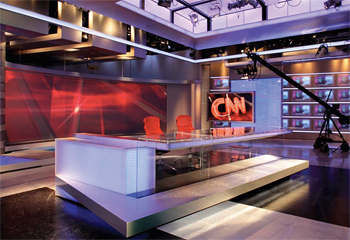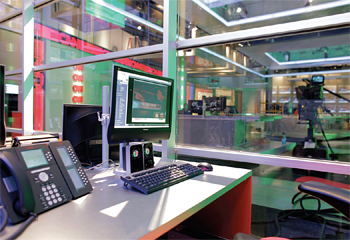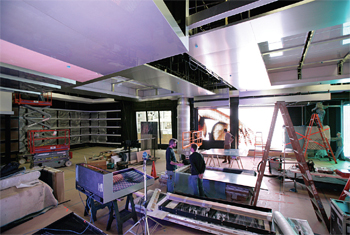CNN Completes its HD Agenda

CNN's new studio features a 3-HDTV projector big screen and rotating anchor desk. Two 103-foot plasma screens can slide back and forth on a track. The redesign included new work spaces. Edward M. Pio Roda/CNN
ATLANTA
When it debuts its latest HDTV news studio later this spring, the new CNN Center studio in Atlanta will mark the conversion of all four of CNN's domestic production centers to HD. The network launched high definition service in 2007, with the HD debut of its New York studio. Over the next two years, its studios in Los Angeles and Washington, D.C. followed suit. And remote crews were equipped with a combination of HD cameras, laptop editors, trucks and "fly-away" systems, as was the CNN Election Express, the network's mobile HD production unit.
Rehearsals at the newly HD Atlanta hub began March 15. HLN (CNN Headline News) primetime programming will be completed by summer.
"CNN Newsroom," "Rick's List," "CNN Saturday Morning," "CNN Sunday Morning" and "Sanjay Gupta, MD" will join the line-up of CNN domestic programming already available in high-definition. CNN HD stands as a separate high-definition signal offering a programming line-up identical to the CNN/US channel broadcast in the standard-definition format.
The entire network will be converted to HD by fall.
THE CHALLENGES OF HD HQ
At CNN's Atlanta headquarters, the more bandwidth-heavy HD format imposed its own constraints, limiting the distance that signals can travel over copper cable before unacceptable degradation sets in.

This is a view into the new studio (taken in mid-March), from the workspace that was designed to be used by show staff during a live show. Edward M. Pio Roda/CNN "There are some real issues with how far you can run HD before you have to re-clock it," said Matthew Holcombe, vice president, Network Support for the CNN Broadcast Engineering and Systems Technology (BEST) group. "We're right around that cliff area."
To address this, Holcombe's team elected to put fiber-optic cabling between the new studio, lodged on the seventh floor (versus its old fifth floor location), and its existing core gear room on the fifth floor.
"It was a challenge to get all that infrastructure in this facility and provide the connectivity we needed for all of the video signals and other requirements," he said. "We had to build a technical space beside the new studio to house all the equipment for the studio."
Buried in the wall, floors and ceilings are 45 miles of copper and fiber optic cabling, according to the network's calculations.
Wireless frequency coordination was also tricky.
"Everything in here is wireless—IFBs, mics—but we can't just worry about the frequencies that we control, we also have to worry about frequencies that come into buildings adjacent to CNN Center," said Holcombe. "We're between Philips Arena and the World Congress Center, so there's a lot of frequency coordination issues."
STUDIO HIGHLIGHTS
According to the official count, the new studio is 5,000 square feet (versus its 1,500-foot predecessor). Its mandate is flexibility in regard to different angles, shots and looks for each of the shows, according to Holcombe.
To this end, the studio includes a 270-degree rotating anchor desk, multiple set locations, a weather center with a perceptive pixel touch screen-generated "magic wall," and more than 50 HD monitors.
Included in the roster of monitors are three 103-inch HD plasma screens: one is mounted on a wall, overlaid with touchscreen capabilities; the other two are mounted on motorized tracks that run above them. Holcombe said that the motorized monitors can be moved along the wall to accommodate more camera angles, or out of the shot altogether.

The studio space, as it looked in mid-January. The anchor set was built in the middle of the studio, and on the left, IPTV-fed monitors were installed. Edward M. Pio Roda/CNN The centerpiece rotating anchor desk, according to Holcombe, was envisioned by CNN Network President Jon Klein. Holcombe noted that a lot of design and effort went into delivering cable that could feed the desk all the technologies (LEDs, computers) required while enabling its unhindered rotation and business as usual in the newsroom located directly underneath the studio.
"Most of the cabling runs across the top of the CNN newsroom and comes up through a penetration in the floor," said Holcombe. "A chain system in the desk houses all the cabling, so that when the desk rotates, the cabling doesn't kink up, or get stretched or broken."
The stage crew can also completely remove the desk for special events.
More than two miles of LED lighting on the floors and in the walls enable production staff to change graphics depending on the show or news environments. And they can be grouped in different zones to compose contiguous animation across the studio.
"All the LED stuff is new—this is an evolution in what we've done in other studios, and one of the key parts of the studio," said Holcombe. "To have a different look from show to show or for breaking news is key."
Holcombe noted that IPTV is "a big investment for the company," used in the studio as well as in control rooms and newsrooms.
"In the past, all of these monitors would have been fed by either a router or the RF in house cable system," he said. "We don't have any RF cable TV in the new studio at all: it's either fed by our big in-house router or it's IPTV fed."
Get the TV Tech Newsletter
The professional video industry's #1 source for news, trends and product and tech information. Sign up below.
